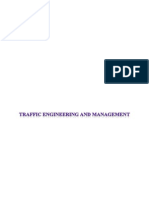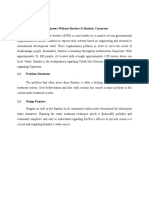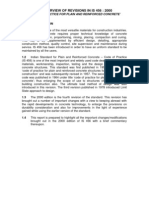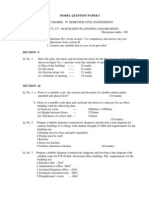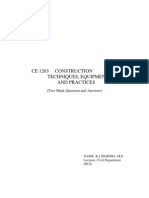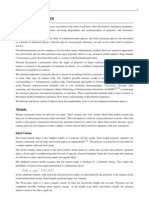BBD - Conference Proceedings
BBD - Conference Proceedings
Uploaded by
Tommy JohnsonCopyright:
Available Formats
BBD - Conference Proceedings
BBD - Conference Proceedings
Uploaded by
Tommy JohnsonOriginal Title
Copyright
Available Formats
Share this document
Did you find this document useful?
Is this content inappropriate?
Copyright:
Available Formats
BBD - Conference Proceedings
BBD - Conference Proceedings
Uploaded by
Tommy JohnsonCopyright:
Available Formats
International Virtual Conference on
Civil Engineering, Architecture and Sustainable Infrastructure
BBDU, Lucknow, Uttar Pradesh, 23rd – 24th, September 2021
Eradication of Iron from Ground Water Using Affordable
Filter Technique
1
S. Vanitha, 2 Dr. N. K. Rajan
1
Research Scholar, Sathyabama Institute of Science and Technology, Chennai, India
2
Professor and Head, M.N.M. Jain Engineering College, Chennai, India
Abstract
Water purity is one of the deciding factors for good health to sustain in the globe. Intentional
as well as non-malicious human activities which include groundwater abstraction, subsurface mining,
vegetation removal, chemical explosions and infrastructure loading are the sources for contamination
of groundwater. This paper deals the low-cost filter technique. Quality of groundwater has enhanced
by removal of total iron concentration from 1.03mg/lit to 0.4mg/lit which permissible limit of iron
concentration is 0.3mg/lit using low-cost solid phase extractor. Sugar cane bagasse adsorbent and pre-
treated neem powder adsorbent have been selected as low-cost filtering extractor. Sugarcane bagasse
removes 61.16% of iron content with 150 grams adsorbent whereas pre-treated Neem powder
removes 50.48% of iron content with 150 grams of adsorbent.
Keywords: Adsorbents, Ground water, Iron, Neem powder, Sugarcane bagasse
INTRODUCTION
The need of Purified water is absolutely essential for healthy life and it has great impacts on people’s everyday
life, especially in the rural and remote areas where access to safe drinking water is very crucial. Fresh
groundwater is sometimes enriched with dissolved ferrous iron (Fe(II)) that restricts its consumption as potable
water because it forms colloidal red matter (mainly ferric ox hydroxides) under toxic conditions at near neutral
pH (>6) conditions. According to WHO standards, the permissible limit of iron in drinking water is 0.3 mg, L.
However, the dumping of domestic and industrial wastes in the water bodies is responsible for elevated levels of
iron in the water. The continuous consumption of such water with high iron content may lead to various health
problems like Bad odor, unpleasant taste, red color of water and stains on laundry and plumbing fixtures are also
some of the issues related with high iron content in water. Statistics shows that these diseases resulted in 90% of
all deaths of children under five years old in developing countries, due to low immunization of children to
infections. Drinking water is being the biggest issue nowadays in India. Most of the people in the rural areas are
not able enough to use water filters or buy mineral water bottles. To overcome this problem many efforts have
been done due to which cleaning water may become an affordable commodity. Every house hold should be able
to develop its own drinking water purification system; this should be the aim of development of any low cost
water purification technique. A variety of techniques have been adapted for the remediation of iron from
different water sources. This review summarizes the approaches used for the removal of iron content from
ground water using natural adsorbents.
EXPERIMENTAL WORK
MATERIALS USED AND PREPARATION OF ADSORBENT MEDIA
Large number of scientists and environmentalists has investigated the possibility and efficiency of utilization of
the natural adsorbents for heavy metal adsorption in polluted water. Following materials were used in removal
of iron from water discussed below.
ICCEASI -21 ISBN: 978-81-951120-7-4
ISBN: 979-8-5412-2027-8
Page | 55
International Virtual Conference on
Civil Engineering, Architecture and Sustainable Infrastructure
BBDU, Lucknow, Uttar Pradesh, 23rd – 24th, September 2021
Reagents
The chemicals used were Sodium hydroxide (NaOH), Acetic acid (CH 3COOH), Calcium Hydroxide Ca(OH)2.
Sodium Hydroxide (NaOH) and PH buffer solutions were used to adjust PH value of samples.
Preparation of Sugarcane bagasse adsorbent
Sugarcane bagasse was initially cleansed meticulously to get rid of dusts by washing with pure water, after that
awash in Sodium Hydroxide for 12 hours and for a second time cleansed healthy through doubly distilled Water.
After that it was drenched in Acetic acid for a period of 2–3 hours to take out the effects of Sodium Hydroxide.
It was meticulously cleansed over by means of doubly distilled water and after that filtered. Allowed to well
dried in the Sun for 6 days and roughly powdered before use.
Preparation of Neem powder adsorbent
The scientific name of Neem is Azadirachta indica. Neem leaves are dried under the Sunlight naturally till the
leaves turn to pale yellow and are kept in open air for some time, with the passage of time chlorophyll material
gets degrade and the leaves were crushed and roughly powdered. Neem leaves powder was taken for removal of
toxic element from water. Neem powder was mixed thoroughly with Calcium hydroxide (chuna) 1:10 ratio.
Chemical formula of calcium hydroxide is Ca(OH)2. It is springily soluble in water and forms a solution called
lime water.
Figure 1 Raw SCB Figure 2 SCB soaked in NaOH Figure 3 Pre-treated SCB
ICCEASI -21 ISBN: 978-81-951120-7-4
ISBN: 979-8-5412-2027-8
Page | 56
International Virtual Conference on
Civil Engineering, Architecture and Sustainable Infrastructure
BBDU, Lucknow, Uttar Pradesh, 23rd – 24th, September 2021
Figure 4 Dry neem leaves Figure 5 Pre-treated Neem
Plain sand
Fine sand is naturally occurring glacial deposits high in silica content and low in soluble calcium, magnesium
and iron compounds are very useful in sedimentation removal. But here the media is used for iron removal from
drinking water. Here for the Experimentation plane sand passing through 600 Micron IS sieve were used after
washing it thoroughly with tap water followed by doubly distilled water (DDW).
Figure 6 Sand used for filtration Figure 7 Washing of sand for removal of impurities
Gravel chips
Gravel filters were found to be very effective for the removal of sediment and heavy metals under all water level
regimes even as the system clogged over time. Despite the sediment particle size distribution being much
smaller than the filter media pore size, sediment and its time associated pollutants were effectively trapped in
the top of the gravel filter.
Figure 8 Gravel chips used for filtration
FILTRATION MODEL DEVELOPMENT
ICCEASI -21 ISBN: 978-81-951120-7-4
ISBN: 979-8-5412-2027-8
Page | 57
International Virtual Conference on
Civil Engineering, Architecture and Sustainable Infrastructure
BBDU, Lucknow, Uttar Pradesh, 23rd – 24th, September 2021
Here we have manufactured a simple cylindrical filtration bottle as shown in Figure with the following
dimensions
Water collecting cylinder
Length = 25 cm
Diameter = 15 cm
Figure 9 Cylinder collecting filtered water
A tap was connected to the bottom cylinder which collects the filtered water that has filtered through the
adsorbents media which is kept in the above the collecting cylinder.
Adsorbents cylinder
Length = 30 cm
Diameter = 7.5cm
Figure 10 Sand and gravel in long cylinder
A supporting container was kept in addition to this cylinder for supporting the lengthy adsorbent cylinder with
the help of pebbles. In this adsorbent cylinder a layer of gravel chips, sand, filter paper and the adsorbents
wrapped in a filter cover was placed respectively. A filter paper was kept at the bottom of the adsorbent media
ICCEASI -21 ISBN: 978-81-951120-7-4
ISBN: 979-8-5412-2027-8
Page | 58
International Virtual Conference on
Civil Engineering, Architecture and Sustainable Infrastructure
BBDU, Lucknow, Uttar Pradesh, 23rd – 24th, September 2021
which was connected with the bottom cylinder to filter the dissolved solids and filter the water. In the proposed
design of the model, the prefabricated water of known iron concentration was passed through the inlet at the top.
Inside the bottle cylinder, different adsorption media of specified thickness were placed with proper gravel
support. Then after filtration, the filtered water was collected through the outlet part in a beaker as show in the
fig.
Figure 11 Model setup
the final concentration was measured in the Atomic Absorption Spectrometer (AAS).The rate of filtration was
noted and for each adsorption media, three samples were tested for each adsorbent and average concentration
was considered for analyzing filter effectiveness.
METHODOLOGY
For removal of iron the natural materials had been used in the experiments i.e. Sugarcane bagasse and Neem
powder mixed with chuna (Calcium Hydroxide) has been adopted. The following adsorption media had been
experimented here for removal of iron from collected raw water sample.
ICCEASI -21 ISBN: 978-81-951120-7-4
ISBN: 979-8-5412-2027-8
Page | 59
International Virtual Conference on
Civil Engineering, Architecture and Sustainable Infrastructure
BBDU, Lucknow, Uttar Pradesh, 23rd – 24th, September 2021
Figure 12 layout of filter media
Sugarcane Bagasse
The pre-treated Sugarcane bagasse, 600 micron sand and gravel chips are taken for filtration process where top
layer is of pre-treated neem Sugarcane bagasse of specific amount of 50 grams, 100 grams, 150 grams is taken
in a filter cover followed by sand and gravel chips at the bottom. Known concentration of raw water sample was
passed through the pre-treated Sugarcane bagasse and filtrate was collected in a beaker then it is filtered through
a Whatman filter paper. The rate of filtration was calculated and final iron concentration was measured.
Figure 13 SCB in Filter media Figure 14 pouring of raw water Figure 15 collecting filtered water
for filtration
ICCEASI -21 ISBN: 978-81-951120-7-4
ISBN: 979-8-5412-2027-8
Page | 60
International Virtual Conference on
Civil Engineering, Architecture and Sustainable Infrastructure
BBDU, Lucknow, Uttar Pradesh, 23rd – 24th, September 2021
Neem leaves powder mixed with chuna
The pre-treated Sugarcane bagasse, 600 micron sand and gravel chips are taken for filtration process where top
layer is of pre-treated neem leaves powder of specific amount of 50 grams, 100 grams, 150 grams is taken in a
filter cover followed by sand and gravel chips at the bottom. Known concentration of raw water sample was
passed through the pre-treated neem powder and filtrate was collected in a beaker then it is filtered through a
Whatman filter paper. The rate of filtration was calculated and final iron concentration was measured.
RESULTS AND ANALYSIS
Sugarcane bagasse
The results are obtained in removal of iron by using Pre-treated Sugarcane bagasse and the effectiveness in
removing iron are tabled here. The initial iron concentration was 1.03 mg/l and the results are shown in the
following Table 1.
Figure 16 Neem powder in filter Figure 17 Pouring of raw water Figure 18 Collecting filtered
media for filtration water
Table 1 Results of filtration Using Sugarcane bagasse
Sample no Amount of SCB used in Initial concentration in Final concentration in
grams mg/lit mg/lit
1. 50 1.03 0.9
2. 100 1.03 0.65
3. 150 1.03 0.4
ICCEASI -21 ISBN: 978-81-951120-7-4
ISBN: 979-8-5412-2027-8
Page | 61
International Virtual Conference on
Civil Engineering, Architecture and Sustainable Infrastructure
BBDU, Lucknow, Uttar Pradesh, 23rd – 24th, September 2021
Neem powder mixed with Calcium hydroxide
The results are obtained in removal of iron by using Neem powder mixed with Calcium hydroxide and the
effectiveness in removing iron is tabled here. The initial iron concentration was 1.03mg/l and the results are
shown in the following Table 2.
Table 2 Results of filtration Using Neem powder mixed with Calcium hydroxide
Sample no Amount of Neem powder Initial concentration in Final concentration in
used in grams mg/lit mg/lit
1. 50 1.03 0.98
2. 100 1.03 0.579
3. 150 1.03 0.51
1.2 Initial concentration Final concentration - SCB Final concentration - NEEM
1.03 1.03 1.03
0.98
1 0.9
0.8
Concentration in mg/lit
0.65
0.579
0.6 0.51
0.4
0.4
0.2
0
1 2 3
Amount of SCB used in grams (1 - 50 grams, 2 - 100 grams and 3 - 150
grams)
Figure 19 Iron removal in Pre-treated Sugarcane bagasse vs Neem powder
ICCEASI -21 ISBN: 978-81-951120-7-4
ISBN: 979-8-5412-2027-8
Page | 62
International Virtual Conference on
Civil Engineering, Architecture and Sustainable Infrastructure
BBDU, Lucknow, Uttar Pradesh, 23rd – 24th, September 2021
100.0
95.1
90.0
80.0 87.4
70.0 66.2
Percentage
60.0
50.0 49.5
40.0 53.1 38.8
30.0
20.0
10.0 SCB NEEM
0.0
1 2 3
Amount of SCB used in grams (1 - 50 grams, 2 - 100 grams and 3 - 150
grams)
Figure 20 Variation of per cent of iron removal using SCB and Neem powder
CONCLUSION
Adsorption being the simplest and cheapest technique for iron removal, it has several advantages, like
longer filtration runs, shorter ripening time, better filtrate quality. But the only limitation is back wash
water requirement is essential for the filter media to run effectively.
Sand being the cheapest adsorbing surface is very effective in removal of dissolved iron from drinking
water and the rate of filtration is also very high. The only demerit is subsequent development of
bacterial layer due to rigorous use. Again, back washing is needed time to time.
Neem leaves powder mixed with chuna which was roughly crushed with hand, the removal is not so
significant. This may be due to lager particle size of material being used. Smaller the size of particle
larger will be the specific surface and better will be the removal.
Pre-treated Sugarcane bagasse proved to be good result in removal of iron compare to pre-treated neem
leaves powder.
REFERENCES
[1] Nitasha Khatri, 2017. Strategies for removal of iron from water, Journal of water process
Engineering, Volume 19, Issue 8, 291-394.
[2] Pandhare & Dawande, 2010. Synthesis of low-cost adsorbent from azadirachta indica (neem) leaf
powder, Archieves of applied science research, Volume 2, Issue 5, 456-461.
[3] Ankit a. jinturkar, 2017. Removal of iron from aqueous solution using neem leaf powder as an
adsorbent, International journal of innovative research in science, engineering and technology, Volume
6, Issue 5, 8948-8952.
[4] Balaji. R, 2014. Removal of iron from drinking, ground water by using agricultural adsorbents,
International Journal of Engineering & Innovative Technology, Volume 3, Issue 12, 43-46.
ICCEASI -21 ISBN: 978-81-951120-7-4
ISBN: 979-8-5412-2027-8
Page | 63
International Virtual Conference on
Civil Engineering, Architecture and Sustainable Infrastructure
BBDU, Lucknow, Uttar Pradesh, 23rd – 24th, September 2021
[5] Deepika B.V & Pradeep Kumar K J, 2016. Iron removal from drinking water using low costs
adsorbents, International journal of innovative research in science, engineering and technology,
Volume 5, Issue 12, 20941-20948.
[6] Indah. S , 2018. Studies on desorption and regeneration of iron removal from aqueous solution,
Water science and technology, Volume 32, Issue 2, 509-515.
[7] Thomas AUDU, 2009. Biosorption of Heavy Metal Ions from Aqueous Solutions Using a Biomaterial
Leonardo journal of sciences, Volume 23, Issue 14, 58-65.
[8] ZU Halim, 2019. Removal and kinetics adsorption of Fe (II) ions in ground water using sugarcane
bagasse of various treatments, International conference on science and innovated engineering (I-
COSINE), Volume 536, 1-8.
[9] Khalid Z. Ekwakeel, 2015. Removal of ferrous and manganese from water by activated carbon
obtained from sugarcane bagasse, Desalination and water treatment journal, Volume 55, Issue 3, 471-
48.
ICCEASI -21 ISBN: 978-81-951120-7-4
ISBN: 979-8-5412-2027-8
Page | 64
You might also like
- Nzove WTP Report 2020 PDFDocument15 pagesNzove WTP Report 2020 PDFNiyibizi Promesse100% (1)
- Traffic Full BookDocument69 pagesTraffic Full BookTommy JohnsonNo ratings yet
- The Effectiveness of Anaerobic Baffled Reactor and Rotating BioloDocument6 pagesThe Effectiveness of Anaerobic Baffled Reactor and Rotating BioloYudhya RatmaNo ratings yet
- Field Visit To Water Treatment Plant, NashikDocument6 pagesField Visit To Water Treatment Plant, NashikMarmik Javare100% (1)
- 7 PDFDocument6 pages7 PDFMithun ChandranNo ratings yet
- Nanomaterials Used For Water PurificationDocument4 pagesNanomaterials Used For Water PurificationInternational Journal of Innovative Science and Research TechnologyNo ratings yet
- Handmade Eco-Friendly Filter Using Rice Husk For Water PurificationDocument6 pagesHandmade Eco-Friendly Filter Using Rice Husk For Water PurificationIJRASETPublicationsNo ratings yet
- Spinel 1Document6 pagesSpinel 1Thai QTNo ratings yet
- Nanotechnology: An Approach For Water Purification-Review: IOP Conference Series: Materials Science and EngineeringDocument12 pagesNanotechnology: An Approach For Water Purification-Review: IOP Conference Series: Materials Science and EngineeringhNo ratings yet
- Ochuko 2022Document6 pagesOchuko 2022luigiNo ratings yet
- 21 TFs IraqDocument9 pages21 TFs IraqKhairi Ali OmarNo ratings yet
- Unidad de Filtración de Múltiples Etapas Portátil y Eficiente Basada en Óxido de Grafeno para Purificación de AguaDocument7 pagesUnidad de Filtración de Múltiples Etapas Portátil y Eficiente Basada en Óxido de Grafeno para Purificación de AguaMARCELO FRANCO CRESPO PLACIDONo ratings yet
- 10 21276ijee 2017 10 0618Document6 pages10 21276ijee 2017 10 0618Akshay SangleNo ratings yet
- Preparationof Household Water FilterDocument9 pagesPreparationof Household Water FilterDark DevilNo ratings yet
- Live in Lab IIIDocument33 pagesLive in Lab IIIr.saibarani2004No ratings yet
- Design of Dual Media Water Filtration System in Debesmscat Mabigo Water ReserveDocument26 pagesDesign of Dual Media Water Filtration System in Debesmscat Mabigo Water ReserveInternational Journal of Innovative Science and Research TechnologyNo ratings yet
- Low Cost Multi Bed Filter For Rainwater Harvesting System in India-IJRASETDocument9 pagesLow Cost Multi Bed Filter For Rainwater Harvesting System in India-IJRASETIJRASETPublicationsNo ratings yet
- Application of Encapsulated and ImmobiliDocument15 pagesApplication of Encapsulated and Immobiliabdulwahabanwar056No ratings yet
- Water Management For Mining - International MiningDocument1 pageWater Management For Mining - International MiningGeoffrey NyamagodoNo ratings yet
- Draft 001Document51 pagesDraft 001muhammedssebatindira3No ratings yet
- Ceramic Water Filter For Point-Of-use Water Treatment in Developing Countries Principles, Challenges and OpportunitiesDocument10 pagesCeramic Water Filter For Point-Of-use Water Treatment in Developing Countries Principles, Challenges and Opportunitieschris.chan.soncio2024No ratings yet
- C ProjectDocument6 pagesC ProjectMEGHANA KNo ratings yet
- Adv Materials Inter - 2022 - Kumar - Hydrogel Nanocomposite Adsorbents and Photocatalysts For Sustainable WaterDocument50 pagesAdv Materials Inter - 2022 - Kumar - Hydrogel Nanocomposite Adsorbents and Photocatalysts For Sustainable WateryuanliliNo ratings yet
- Science of The Total EnvironmentDocument13 pagesScience of The Total EnvironmentDALILANo ratings yet
- Live in Lab III Document WiDocument35 pagesLive in Lab III Document Wir.saibarani2004No ratings yet
- Design of Underground Drainage System For Kapuskhed VillageDocument5 pagesDesign of Underground Drainage System For Kapuskhed VillageInternational Journal of Innovative Science and Research TechnologyNo ratings yet
- Hybrid Ion Exchange - Pressure Driven Membrane Processes in Water Treatment A Review PDFDocument12 pagesHybrid Ion Exchange - Pressure Driven Membrane Processes in Water Treatment A Review PDFalabdulgaderNo ratings yet
- Evaluation of Ceramic Water Filter Absorbent Pot Produced From Blending Groundnut Shell and Rice Husk For Rural Water PurificationDocument6 pagesEvaluation of Ceramic Water Filter Absorbent Pot Produced From Blending Groundnut Shell and Rice Husk For Rural Water PurificationPalanivelu SureskumarNo ratings yet
- An Overview of Silver Nano-Particles As Promising Materials For Water DisinfectionDocument21 pagesAn Overview of Silver Nano-Particles As Promising Materials For Water Disinfectionalan.lym0530No ratings yet
- Biosand Filter BSF - Types and Mechanisms Behind Its EfficiencyDocument16 pagesBiosand Filter BSF - Types and Mechanisms Behind Its EfficiencyjcbobedaNo ratings yet
- Water Trash Collector BoatDocument8 pagesWater Trash Collector BoatRushikesh khotNo ratings yet
- A Review Paper On Low-Cost Water Filtration ProcessDocument2 pagesA Review Paper On Low-Cost Water Filtration ProcessOm ShahiNo ratings yet
- Amm 898 9Document8 pagesAmm 898 9Dien NoelNo ratings yet
- Practical Research 2 Q1 Group3 12STEM Wisdom Chapters III and IIIDocument70 pagesPractical Research 2 Q1 Group3 12STEM Wisdom Chapters III and IIIkriszamae.udaniNo ratings yet
- Low-Cost Stormwater Filtration System To Improve UDocument14 pagesLow-Cost Stormwater Filtration System To Improve Uajkings2551No ratings yet
- 1 s2.0 S2212371722000014 MainDocument12 pages1 s2.0 S2212371722000014 MainRodrigo Alvim HudsonNo ratings yet
- Field Visit To Water Treatment Plant, AluvaDocument6 pagesField Visit To Water Treatment Plant, AluvaAdinathNo ratings yet
- IWWA2019Document8 pagesIWWA2019Mi doremiNo ratings yet
- 1.0 1.1 Background of Engineers Without Borders & Bambui, CameroonDocument16 pages1.0 1.1 Background of Engineers Without Borders & Bambui, CameroonCalvinhaoweiNo ratings yet
- SEMINAR REPORT CHIRANJEEB SAHOO EditedDocument25 pagesSEMINAR REPORT CHIRANJEEB SAHOO Editedsaraswatdas94No ratings yet
- Prosiding Internasional 8-The Analysis of Banana PeelsDocument8 pagesProsiding Internasional 8-The Analysis of Banana PeelsIswanto MMTNo ratings yet
- WastewaterEngineering DOIDocument220 pagesWastewaterEngineering DOIAkasH BinDNo ratings yet
- Polusi 8Document25 pagesPolusi 8Farhan Nur HakimNo ratings yet
- Final ReportDocument51 pagesFinal ReportAkash RaviNo ratings yet
- Anaerobic Baffled Reactor-A Sustainable Approach For Coconut Husk RettingDocument6 pagesAnaerobic Baffled Reactor-A Sustainable Approach For Coconut Husk RettingJASH MATHEWNo ratings yet
- Cellulose Based NanocompositesDocument7 pagesCellulose Based NanocompositesAnuragNo ratings yet
- WATER FILTER Ahmed Kazeem CorrectionDocument30 pagesWATER FILTER Ahmed Kazeem Correctioncompcleverkid81No ratings yet
- Mowla 2020 IOP Conf. Ser. Earth Environ. Sci. 581 012027Document8 pagesMowla 2020 IOP Conf. Ser. Earth Environ. Sci. 581 012027Monique BarbaraNo ratings yet
- 1 s2 0 s0959652621035976 MainDocument14 pages1 s2 0 s0959652621035976 MainMohamed MotaweaNo ratings yet
- Portable Treatment Plant For Institutional Canteen Waste Water ManagementDocument6 pagesPortable Treatment Plant For Institutional Canteen Waste Water ManagementInternational Journal of Innovative Science and Research TechnologyNo ratings yet
- Visvesvaraya Technological University Final Year ProjectDocument13 pagesVisvesvaraya Technological University Final Year ProjectsathyapoloNo ratings yet
- Nofiana 2019 IOP Conf. Ser. Earth Environ. Sci. 248 012053Document8 pagesNofiana 2019 IOP Conf. Ser. Earth Environ. Sci. 248 012053azizia harmesNo ratings yet
- 2013-WAITE-Ceramic Water FiltersDocument11 pages2013-WAITE-Ceramic Water FiltersLuis DupuyNo ratings yet
- 2013 WAITE Ceramic Water FiltersDocument11 pages2013 WAITE Ceramic Water FiltersLuis DupuyNo ratings yet
- 1 s2.0 S2773207X23000271 MainDocument21 pages1 s2.0 S2773207X23000271 MainmikensiluNo ratings yet
- Colloid and Interface Science Communications: SciencedirectDocument12 pagesColloid and Interface Science Communications: Sciencedirectchirag chawareNo ratings yet
- EVS Microproject ReportDocument21 pagesEVS Microproject ReporttejasgaminghubNo ratings yet
- Membranes 12 00923 v2Document10 pagesMembranes 12 00923 v2Elizabeth BennetNo ratings yet
- Ws 022011120Document11 pagesWs 022011120abdulwahabanwar056No ratings yet
- Godavari PollutionDocument3 pagesGodavari PollutionPriya JohnsonNo ratings yet
- Environmental Safeguard Monitoring Field Kit: Project Implementation Directorate, NepalFrom EverandEnvironmental Safeguard Monitoring Field Kit: Project Implementation Directorate, NepalNo ratings yet
- The Secretary/Principal Secretary: Can Be Placed With The Schemes Such As MGNREGS, PMAY, NSAP, Cte, As Per TheirDocument2 pagesThe Secretary/Principal Secretary: Can Be Placed With The Schemes Such As MGNREGS, PMAY, NSAP, Cte, As Per TheirTommy JohnsonNo ratings yet
- ABSORPTIONDocument75 pagesABSORPTIONTommy JohnsonNo ratings yet
- Pharmaco DynamicsDocument11 pagesPharmaco DynamicsTommy JohnsonNo ratings yet
- Pharmaco DynamicsDocument11 pagesPharmaco DynamicsTommy JohnsonNo ratings yet
- Transposition of The Great Arteries (TGA)Document4 pagesTransposition of The Great Arteries (TGA)Tommy JohnsonNo ratings yet
- Experimental Study On Hollow Blocks With Wastes: ProceedingsDocument7 pagesExperimental Study On Hollow Blocks With Wastes: ProceedingsTommy JohnsonNo ratings yet
- Meaning of AccountingDocument9 pagesMeaning of AccountingTommy JohnsonNo ratings yet
- Is 456Document26 pagesIs 456Tommy JohnsonNo ratings yet
- Building DrawingDocument6 pagesBuilding DrawingTommy JohnsonNo ratings yet
- CE 1203 Construction TechniquesDocument18 pagesCE 1203 Construction Techniquestitukutty6032No ratings yet
- F00414EN-08 - 077011 - Intrerupator Cap-ScaraDocument3 pagesF00414EN-08 - 077011 - Intrerupator Cap-ScaraRazvan PanaNo ratings yet
- American Woodworker - 82 (October 2000)Document78 pagesAmerican Woodworker - 82 (October 2000)Emilian Baluta100% (2)
- Produccion Cacao Colombia (Cascara de Cacao)Document7 pagesProduccion Cacao Colombia (Cascara de Cacao)JENNIFER TATIANA PORRAS OLIVEROSNo ratings yet
- Etching Titanium With HF and Nitric Acid SolutionsDocument13 pagesEtching Titanium With HF and Nitric Acid SolutionsKazuoNo ratings yet
- Material Safety Data Sheet: (PMP Name) - 3742002190 (ACEP Name & Code)Document3 pagesMaterial Safety Data Sheet: (PMP Name) - 3742002190 (ACEP Name & Code)dieseljccNo ratings yet
- STD - 5th SCIENCE 2023 (Half Yearly Exam) - 1Document3 pagesSTD - 5th SCIENCE 2023 (Half Yearly Exam) - 1AlokNo ratings yet
- Manual Soil-Treatment Excerpt GBDocument15 pagesManual Soil-Treatment Excerpt GBAliNo ratings yet
- Ground Support in Mining and Underground ConstructDocument9 pagesGround Support in Mining and Underground Constructrowa.fangNo ratings yet
- Activity No. 4 Qualitative Test For Lipid - ADocument5 pagesActivity No. 4 Qualitative Test For Lipid - APatricia Willyn DiosoNo ratings yet
- Hard LandscapeDocument52 pagesHard LandscapeDharani Gowd100% (2)
- John Crane Gas Seals: Gas Seals and Their Application For Maximum ReliabilityDocument41 pagesJohn Crane Gas Seals: Gas Seals and Their Application For Maximum ReliabilityDoctorObermanNo ratings yet
- S4 Plastic Material Requirment DetailsDocument10 pagesS4 Plastic Material Requirment Detailslaiju csNo ratings yet
- Polymer PhysicsDocument4 pagesPolymer PhysicsThanga GanapathyNo ratings yet
- Recovery of Asphalt From Solution by Abson MethodDocument3 pagesRecovery of Asphalt From Solution by Abson MethodEvert RiveraNo ratings yet
- Sporicidal Activity of GlutaraldehydeDocument13 pagesSporicidal Activity of GlutaraldehydeIlma YudistianNo ratings yet
- Adsorption Modeling With The Esd Equation of State: Aaron D. Soule, Cassandra A. Smith, Xiaoning Yang Carl T. LiraDocument38 pagesAdsorption Modeling With The Esd Equation of State: Aaron D. Soule, Cassandra A. Smith, Xiaoning Yang Carl T. LiraSanjeeva YedavalliNo ratings yet
- Class 11 Chapter 1 Chemistry Important QuestionsDocument8 pagesClass 11 Chapter 1 Chemistry Important QuestionsradhavenkateshwaranNo ratings yet
- BIOCHEMICAL OXYGEN DEMAND (Compatibility Mode)Document32 pagesBIOCHEMICAL OXYGEN DEMAND (Compatibility Mode)Sunny DesharNo ratings yet
- OPGW CatalogDocument6 pagesOPGW CatalogKrishna VenkataramanNo ratings yet
- AamchurDocument4 pagesAamchursadiaNo ratings yet
- Pressure Vessels PartsDocument3 pagesPressure Vessels PartssafwanNo ratings yet
- Level 2 - H2S CertificateDocument51 pagesLevel 2 - H2S CertificateHadi HendizadehNo ratings yet
- Shape Memory Alloy For Sound VibrationDocument25 pagesShape Memory Alloy For Sound VibrationForsythe LearningNo ratings yet
- WPS, PQR and WPQDocument31 pagesWPS, PQR and WPQDhrumil Chauhan100% (2)
- 18 Aakriti Koirala Unbound PavementDocument51 pages18 Aakriti Koirala Unbound PavementDinesh RegmiNo ratings yet
- Buet Question of 2015-2016 (L-2 T-1) - CeDocument18 pagesBuet Question of 2015-2016 (L-2 T-1) - CePicasso Debnath0% (1)
- Environmental Remediation Technologies For Metal-Contaminated SoilsDocument257 pagesEnvironmental Remediation Technologies For Metal-Contaminated SoilsJhonatan Perez EspinozaNo ratings yet
- Nanoelectronics: ECT292 Category L T P CreditDocument7 pagesNanoelectronics: ECT292 Category L T P CreditanoopegNo ratings yet
- Analytical Chemistry 20132Document1 pageAnalytical Chemistry 20132zzrot1No ratings yet
- Bap - Uf SystemDocument88 pagesBap - Uf SystemGloria HamiltonNo ratings yet

